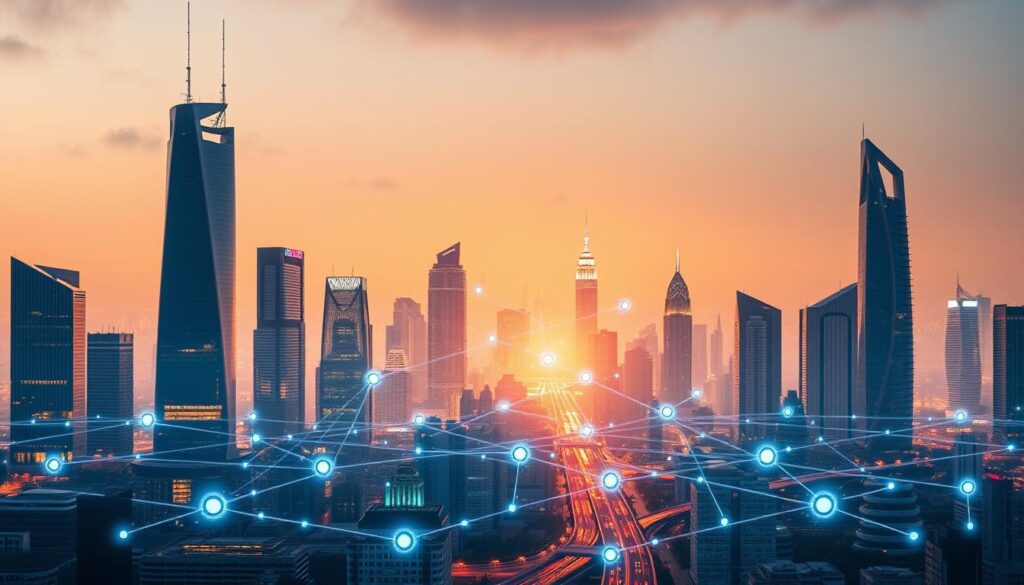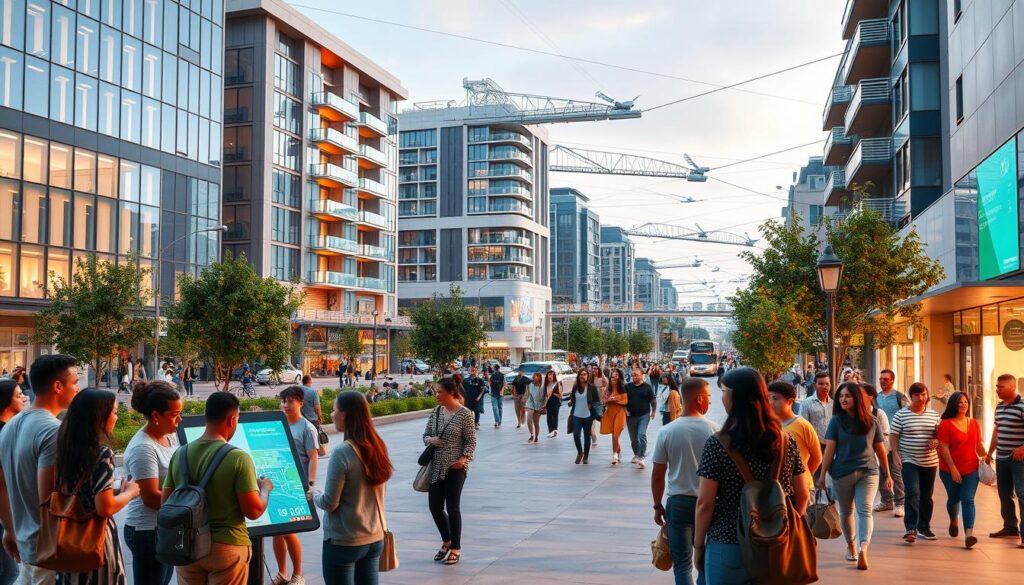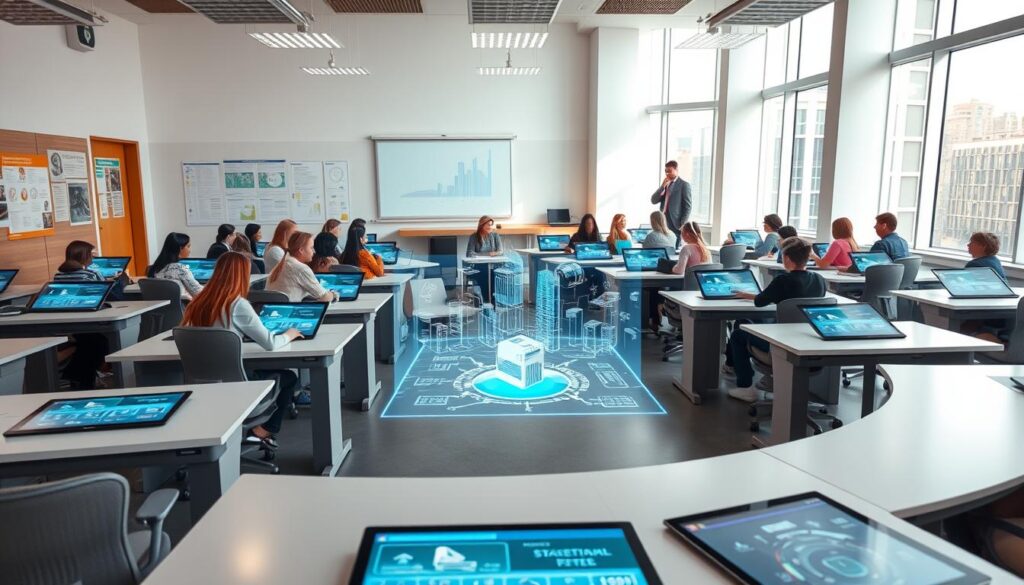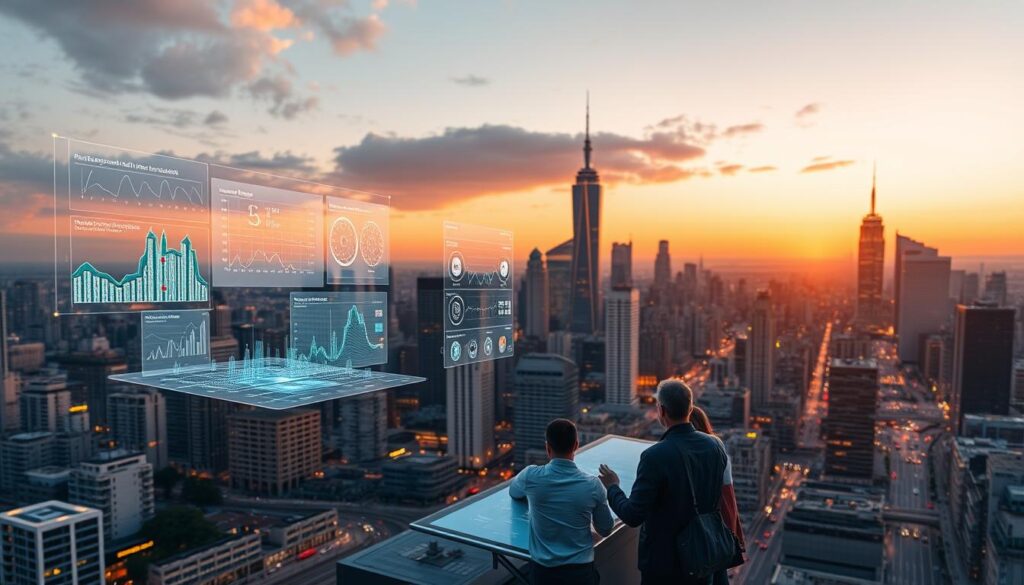The U.S. Department of Transportation has made a significant investment in smart city initiatives, leveraging nearly $350 million in public and private funds for smart city and advanced transportation technologies.
This substantial investment underscores the growing importance of integrating advanced building technology in urban development projects across the USA. As cities become increasingly interconnected, the need for efficient, sustainable, and technologically advanced infrastructure is becoming a top priority. By embracing innovative technologies, cities can improve the quality of life for their citizens, reduce environmental impact, and drive economic growth.
Key Takeaways
- Significant investments are being made in smart city initiatives across the USA.
- Advanced building technology is crucial for efficient and sustainable urban development.
- Innovative technologies can improve the quality of life for citizens and drive economic growth.
- Smart city projects are expected to reduce environmental impact and enhance infrastructure.
- The integration of advanced technologies is a key priority for urban development.
Introduction to Smart Cities and Building Technology
With the rise of urbanization, cities like New York, San Francisco, and Chicago are at the forefront of adopting smart city technologies to create more livable spaces. The concept of smart cities is not just about technology; it’s about creating sustainable, efficient, and livable urban environments.
Defining Smart Cities
Smart cities utilize advanced technology to improve infrastructure, services, and the quality of life for their citizens. This involves integrating various systems and services, such as transportation, energy, and public safety, into a cohesive and efficient network. For more information on how cities are leveraging technology, visit Building Smart Cities and Infrastructure.
The defining characteristic of a smart city is its ability to harness technology to drive innovation and sustainability. This includes implementing smart grids, intelligent transportation systems, and advanced public safety measures.
The Role of Technology in Urban Development
Technology plays a pivotal role in urban development, enabling cities to become more sustainable, efficient, and livable. From IoT devices to data analytics, technology helps cities manage resources better, reduce waste, and improve services.
Some key technologies driving smart city initiatives include:
- Internet of Things (IoT) devices for real-time monitoring
- Data analytics for informed decision-making
- Artificial intelligence for predictive maintenance
Let’s examine some statistics on smart city technology adoption:
| City | Smart City Initiative | Impact |
|---|---|---|
| New York | Smart Grid Implementation | Reduced energy consumption by 15% |
| San Francisco | Intelligent Transportation System | Decreased traffic congestion by 20% |
| Chicago | Smart Lighting Systems | Saved $100,000 annually on energy |
The integration of advanced building technology is crucial for the development of smart cities. By leveraging these technologies, cities can create more sustainable, efficient, and livable environments for their citizens.
Key Components of Advanced Building Technology

The future of urban development hinges on the successful integration of advanced building technologies. As cities evolve, the incorporation of digital infrastructure solutions is crucial for creating efficient, sustainable, and livable environments.
IoT and Connectivity
The Internet of Things (IoT) is a cornerstone of smart city initiatives, enabling the connection and interaction of various devices and systems. This connectivity facilitates real-time data collection and analysis, which is vital for managing urban resources effectively.
IoT devices are being used in various applications, from traffic management to waste management, enhancing the overall quality of urban living.
Automation and AI
Automation and Artificial Intelligence (AI) are transforming urban infrastructure by optimizing building operations and improving energy efficiency. AI-driven systems can predict and respond to various urban needs, making cities more adaptive and resilient.
For instance, AI can be used to optimize heating and cooling systems in buildings, reducing energy consumption and costs.
Energy Efficiency Solutions
Energy efficiency is a critical aspect of advanced building technology. Solutions such as smart grids and energy-efficient buildings are being implemented to reduce energy consumption and promote sustainability.
| Technology | Application | Benefit |
|---|---|---|
| IoT Devices | Real-time monitoring | Enhanced efficiency |
| AI-driven Systems | Predictive maintenance | Reduced costs |
| Smart Grids | Energy distribution | Increased sustainability |
By integrating these key components, cities can achieve significant improvements in sustainability and quality of life, paving the way for a smarter, more connected future.
Benefits of Integration in Smart Cities
The fusion of technology and urban planning is creating more sustainable and livable cities. Advanced building technology is playing a pivotal role in shaping the future of urban development.
Improved Quality of Life
Smart city initiatives have shown to reduce congestion, improve air quality, and enhance public safety. For instance, intelligent transportation systems can optimize traffic flow, reducing commute times and lowering emissions.
Key Improvements:
- Reduced traffic congestion
- Improved air quality
- Enhanced public safety
Enhanced Sustainability
Urban sustainability initiatives are crucial for the long-term viability of cities. By integrating green technologies and renewable energy sources, cities can significantly reduce their environmental footprint.
| Sustainability Measure | Impact |
|---|---|
| Renewable Energy Adoption | Reduced carbon emissions |
| Green Building Practices | Lower energy consumption |
| Efficient Water Management | Conservation of water resources |
Economic Growth Potential
Innovative city planning not only improves the quality of life but also attracts businesses and talent, driving economic growth. Smart cities are becoming hubs for innovation and entrepreneurship.
By embracing advanced building technology, cities can create a thriving environment that supports both residents and businesses. This, in turn, can lead to increased economic opportunities and a higher standard of living.
Case Studies of Smart City Initiatives in the USA

Smart city initiatives are revolutionizing urban landscapes in the USA, enhancing the quality of life for citizens. Various cities have taken significant steps towards becoming smarter, more sustainable, and efficient.
New York City’s Smart Building Projects
New York City has been at the forefront of smart building technology, implementing various projects to reduce energy consumption and enhance sustainability. One notable initiative is the NYC Plaza Program, which encourages building owners to adopt energy-efficient practices.
For more examples of smart city initiatives, visit https://www.digi.com/blog/post/smart-cities-in-the-us-examples.
| City | Initiative | Outcome |
|---|---|---|
| New York City | NYC Plaza Program | Reduced energy consumption by 20% |
| San Francisco | Integrated Infrastructure | Improved public transportation efficiency by 15% |
| Chicago | Smart Lighting Systems | Saved $1 million annually on energy costs |
San Francisco’s Integrated Infrastructure
San Francisco has focused on integrating its infrastructure to create a more efficient and connected city. The San Francisco Municipal Transportation Agency has implemented smart traffic management systems to reduce congestion and improve public transportation.
Chicago’s Smart Lighting Systems
Chicago has made significant strides with its smart lighting initiatives, replacing traditional streetlights with LED lights that are energy-efficient and can be controlled remotely. This initiative has not only reduced energy costs but also improved public safety.
These case studies demonstrate the diverse approaches cities are taking to become smarter and more sustainable. By leveraging advanced technologies, cities like New York, San Francisco, and Chicago are setting examples for others to follow.
Challenges in Technology Integration
Despite the numerous benefits, smart city initiatives often face significant hurdles in technology integration. The complexity of merging various technological systems into a cohesive and efficient network can be daunting.
High Initial Investment Costs
One of the primary challenges is the high initial investment required for implementing digital infrastructure solutions. The cost of installing smart grids, intelligent transportation systems, and other advanced technologies can be prohibitively expensive for many municipalities.
To mitigate these costs, cities are exploring innovative financing models, such as public-private partnerships (P3s), to fund their smart city projects. This approach not only helps in distributing the financial burden but also brings in expertise from the private sector.
Data Privacy and Security Concerns
Another significant challenge is ensuring the privacy and security of data collected by smart city technology solutions. As cities become increasingly connected, the risk of cyberattacks and data breaches grows, potentially compromising sensitive information.
- Implementing robust cybersecurity measures is crucial.
- Ensuring compliance with data protection regulations is essential.
- Raising awareness among citizens about data privacy can foster trust.
Interoperability Between Systems
The issue of interoperability between different technological systems is also a significant hurdle. For a smart city to function effectively, various systems must be able to communicate and work together seamlessly.
To address this, cities are adopting standardized protocols and frameworks that facilitate interoperability, enabling a more integrated and efficient urban infrastructure.
In conclusion, while there are challenges to technology integration in smart cities, there are also potential solutions and strategies that can be employed to overcome these hurdles, paving the way for more sustainable, efficient, and livable urban environments.
Policy and Regulatory Framework

Effective policy and regulatory frameworks are the backbone of innovative city planning and urban sustainability initiatives. As cities in the United States continue to adopt smart technologies, the role of government policies and regulations becomes increasingly crucial.
The U.S. Department of Transportation and other federal agencies have been instrumental in issuing guidelines and providing funding for smart city projects. These efforts aim to promote the integration of advanced technologies into urban infrastructure, enhancing the quality of life for citizens and fostering sustainable development.
Federal Guidelines on Smart Cities
Federal guidelines play a pivotal role in shaping the smart city landscape. They provide a framework for cities to follow, ensuring that the development of smart infrastructure is aligned with national objectives and standards.
- Guidelines on data privacy and security
- Standards for interoperability between different systems
- Funding opportunities for smart city initiatives
State-Level Innovations and Restrictions
While federal guidelines provide a broad framework, state-level policies can significantly influence the pace and direction of smart city development. Some states have been at the forefront of innovation, introducing policies that encourage the adoption of smart technologies.
For instance, states like California and New York have implemented regulations that support the growth of smart cities, while other states may have more restrictive policies.
Local Government Initiatives
Local governments are also playing a crucial role in smart city development. Many cities are launching their own initiatives, tailored to their specific needs and challenges.
- Smart lighting systems to reduce energy consumption
- Integrated transportation systems to improve mobility
- Smart building codes to enhance energy efficiency
In conclusion, the policy and regulatory framework is a critical component of smart city development in the USA. By understanding and navigating these frameworks, stakeholders can better leverage opportunities for growth and innovation.
Sustainable Practices in Building Technology
Sustainable practices in building technology are revolutionizing the way cities are designed and operated. The integration of green technologies and innovative solutions is crucial for creating resilient urban environments.
Smart Grids and Energy Conservation
One of the key aspects of sustainable building technology is the implementation of smart grids. These grids enable efficient energy distribution and consumption, reducing waste and promoting renewable energy sources. By leveraging advanced technologies like IoT and AI, smart grids can predict energy demand and adjust supply accordingly, leading to significant energy conservation.
Water Management Innovations
Effective water management is another critical component of sustainable urban development. Innovations such as rainwater harvesting systems and greywater reuse are being integrated into building designs to minimize water waste and reduce the strain on municipal water supplies. These systems not only conserve water but also decrease the energy required for water treatment and transportation.
Green Building Certifications
Green building certifications like LEED (Leadership in Energy and Environmental Design) play a vital role in promoting sustainable building practices. These certifications provide a framework for builders and architects to design and construct buildings that meet rigorous environmental standards. By achieving green building certifications, buildings can demonstrate their commitment to sustainability and energy efficiency.
The adoption of these sustainable practices in building technology is not only beneficial for the environment but also enhances the quality of life for urban residents. As cities continue to evolve, the integration of such technologies will be crucial in creating a more sustainable and resilient urban future.
Community Engagement and Participation

As cities become smarter, the role of community engagement in shaping these cities cannot be overstated. The success of smart city initiatives heavily relies on the active participation and input of their communities.
Importance of Public Input
Public input is vital for understanding the needs and concerns of the community, ensuring that smart city projects are tailored to benefit the residents. Cities like Boston have successfully engaged residents through apps to report infrastructure issues, thereby enhancing community participation and fostering a sense of ownership among citizens.
By involving the community in the decision-making process, cities can ensure that their initiatives are not only technologically advanced but also socially acceptable and beneficial. This collaborative approach helps in identifying potential issues early on and in devising solutions that are more likely to be embraced by the community.
Strategies for Effective Community Programs
Effective community engagement requires thoughtful strategies. Some of the key approaches include:
- Utilizing digital platforms for feedback and participation
- Organizing community events and workshops
- Implementing transparent and open communication channels
For instance, cities can leverage engineering innovations to create interactive and inclusive community programs that encourage participation and foster a sense of community.
Case Examples of Successful Collaborations
Several cities have demonstrated successful collaborations between municipal authorities and residents. For example, community-led initiatives in urban sustainability have shown promising results in enhancing the quality of life in urban areas.
These collaborations not only contribute to the development of more livable and sustainable cities but also empower communities by giving them a voice in the urban planning process.
The Future of Building Technology in Urban Areas
With the rapid pace of urbanization, the need for intelligent infrastructure integration has become more pressing than ever. Cities are becoming hubs for innovation, and building technology is at the forefront of this transformation.
Predictions for Smart Cities Post-2025
Looking ahead to 2025 and beyond, smart cities are expected to become even more interconnected. Technologies such as 5G, AI, and blockchain will play a pivotal role in shaping urban landscapes. For instance, smart city technology solutions will enable more efficient management of resources, improved public services, and enhanced quality of life for citizens.
The integration of these technologies will lead to the development of more sustainable and resilient cities. For example, smart grids will optimize energy distribution, while AI-powered traffic management systems will reduce congestion and pollution.
Emerging Technologies on the Horizon
Several emerging technologies are set to revolutionize urban development. Some of the key technologies include:
- Advanced IoT devices for real-time monitoring
- Blockchain for secure data management
- 5G networks for faster data transfer
- AI and machine learning for predictive analysis
These technologies will not only improve the efficiency of urban operations but also provide a better living experience for citizens.
The Role of Startups in Innovation
Startups are playing a crucial role in driving innovation in building technology. They bring fresh perspectives and new ideas to the table, often leveraging the latest technologies to create innovative solutions.
For example, many startups are developing smart building solutions that integrate with city infrastructure, enhancing the overall efficiency and sustainability of urban environments.
| Technology | Application | Benefit |
|---|---|---|
| 5G Networks | Faster data transfer | Enhanced connectivity |
| AI and Machine Learning | Predictive analysis | Improved decision-making |
| Blockchain | Secure data management | Increased security |
Education and Workforce Development

Education and workforce development are pivotal in shaping the future of smart cities through advanced building technologies. As urban areas become increasingly interconnected, the demand for professionals skilled in smart building technology is on the rise.
The integration of advanced technologies in urban infrastructure necessitates a workforce that is not only adept in traditional construction methods but also well-versed in modern technological advancements. This includes proficiency in areas such as IoT, AI, and energy efficiency solutions.
Training Programs for Smart City Professionals
To meet the growing needs of the smart city sector, various training programs have been developed. These programs focus on equipping professionals with the skills required to design, implement, and manage smart city projects.
- Specialized courses in smart building technology
- Workshops on IoT and connectivity
- Training sessions on AI and automation
- Certification programs in energy efficiency and sustainability
Importance of STEM Education
STEM education (Science, Technology, Engineering, and Mathematics) plays a crucial role in preparing the future workforce for the challenges of smart city development. By emphasizing STEM education, we can ensure that the next generation of professionals is equipped to innovate and lead in the field of smart building technology.
Key benefits of STEM education include:
| Benefit | Description |
|---|---|
| Innovation | Fosters creativity and innovation in solving urban challenges |
| Technical Skills | Provides a strong foundation in technical skills necessary for smart city technologies |
| Problem-Solving | Enhances problem-solving abilities, crucial for managing complex urban systems |
Partnerships with Educational Institutions
Collaboration between industry stakeholders and educational institutions is vital for developing curricula that are relevant to the needs of the smart city sector. Such partnerships can lead to the creation of tailored programs that address specific skill gaps.
Examples of successful partnerships include:
- University-industry research collaborations
- Internship programs for students
- Customized training programs for professionals
By focusing on education and workforce development, we can ensure that the workforce is prepared to support the continued growth and development of smart cities.
Funding and Investment Opportunities
Funding for smart city projects is a critical component of their success, with opportunities arising from federal grants, private sector investments, and crowdfunding. The availability of these funding sources can significantly impact the development and implementation of smart city initiatives across the USA.
Federal Grants for Smart City Projects
The U.S. Department of Transportation has provided significant funding for smart city initiatives, supporting projects that enhance urban mobility and infrastructure. For instance, the Smart City Challenge launched in 2015 allocated $40 million to Columbus, Ohio, to develop a comprehensive smart city plan.
Other federal agencies, such as the Department of Energy and the Department of Housing and Urban Development, also offer grants that can be utilized for smart city projects. These grants often focus on specific areas like energy efficiency, sustainable development, and innovative technology integration.
| Federal Agency | Grant Program | Focus Area |
|---|---|---|
| U.S. Department of Transportation | Smart City Challenge | Urban Mobility, Infrastructure |
| U.S. Department of Energy | Energy Efficiency Grants | Energy Conservation, Sustainable Technologies |
| U.S. Department of Housing and Urban Development | Sustainable Development Grants | Sustainable Communities, Green Infrastructure |
Role of Private Sector in Tech Funding
Private sector investment is also on the rise, with companies recognizing the potential of smart city technologies. Venture capital firms and technology giants are investing heavily in startups and projects that offer innovative digital infrastructure solutions.
“The private sector is playing an increasingly important role in funding smart city initiatives, bringing not only financial resources but also expertise and innovation.”
Private investments can help bridge the funding gap for smart city projects, enabling cities to implement advanced technologies and improve urban living.
Crowdfunding for Community Initiatives
Crowdfunding has emerged as a viable option for community-driven smart city initiatives. Platforms like Kickstarter and Indiegogo allow communities to raise funds for specific projects, fostering public engagement and ownership.
Crowdfunding can be particularly effective for projects that have a direct impact on local communities, such as smart lighting systems or community Wi-Fi networks. By involving the community in the funding process, cities can ensure that projects meet local needs and enjoy broad support.
Tools and Methods for Integration

The integration of advanced building technology in smart cities relies heavily on innovative tools and methodologies. As urban areas continue to evolve, the need for efficient, scalable, and sustainable solutions becomes increasingly important.
One of the key technologies driving this integration is Building Information Modeling (BIM). BIM allows for the creation of detailed digital representations of physical and functional characteristics of buildings and infrastructure. This technology facilitates better collaboration among stakeholders, improves accuracy in construction and maintenance, and enhances the overall lifecycle management of buildings.
Building Information Modeling (BIM)
BIM is not just a tool but a process that involves creating and managing information throughout a project’s lifecycle. It enables architects, engineers, contractors, and owners to collaborate more effectively, reducing errors and improving project outcomes.
The benefits of BIM include:
- Improved project visualization
- Enhanced collaboration among stakeholders
- Better cost estimation and management
- Reduced construction delays
Smart Sensors and Real-time Data Analysis
Another crucial element in the integration of smart city infrastructure is the use of smart sensors and real-time data analysis. These technologies enable cities to monitor and manage their infrastructure more effectively, responding to issues before they become major problems.
| Technology | Application | Benefits |
|---|---|---|
| Smart Sensors | Monitoring environmental conditions, traffic flow, and energy usage | Real-time data for informed decision-making, improved efficiency |
| Real-time Data Analysis | Analyzing data from various sources for insights | Predictive maintenance, optimized resource allocation |
Cloud Computing Solutions
Cloud computing plays a vital role in supporting the infrastructure of smart cities by providing scalable, secure, and flexible data management solutions. It enables the integration of data from various sources, facilitating a more holistic approach to urban planning and management.
Cloud computing solutions offer several advantages, including:
- Scalability to meet growing data needs
- Enhanced security features to protect sensitive information
- Flexibility in accessing data from anywhere
As smart cities continue to evolve, the integration of technologies like BIM, smart sensors, and cloud computing will be crucial. These tools not only enhance the efficiency and sustainability of urban infrastructure but also improve the quality of life for residents.
Impact of Climate Change on City Planning
Climate change is increasingly becoming a critical factor in city planning, necessitating innovative and resilient urban development strategies. Cities are at the forefront of dealing with the challenges posed by climate change, from rising sea levels to extreme weather events.
As urban areas continue to grow, the need for sustainable urban development practices becomes more pressing. This involves not just adapting to the current impacts of climate change but also planning for future resilience.
Designing Resilient Infrastructure
One of the key strategies in addressing climate change is designing infrastructure that can withstand its impacts. This includes building sea walls to protect against rising sea levels, implementing green roofs to mitigate the urban heat island effect, and constructing buildings that can resist extreme weather conditions.
According to a report by the American Planning Association, “the integration of climate resilience into infrastructure planning is crucial for the long-term viability of urban areas” (https://www.planning.org/publications/report/9226594/).
Role of Green Technology
Green technology plays a vital role in reducing the carbon footprint of cities and enhancing their resilience to climate change. This includes the use of renewable energy sources, green building materials, and smart grids to manage energy distribution efficiently.
- Renewable energy sources such as solar and wind power
- Green building certifications like LEED
- Smart grids for efficient energy management
Climate Adaptation Strategies
Cities are adopting various climate adaptation strategies to mitigate the impacts of climate change. These include early warning systems for extreme weather events, climate-resilient water management systems, and urban forestry initiatives to reduce the urban heat island effect.
As noted by urban planners, “adaptation is key to survival in the face of climate change, and cities that proactively plan for its impacts will be better positioned to thrive.”
In conclusion, the impact of climate change on city planning is profound, necessitating a comprehensive approach that includes resilient infrastructure, green technology, and effective adaptation strategies. By prioritizing sustainable urban development, cities can not only mitigate the effects of climate change but also create a more livable and prosperous future for their residents.
Leveraging Data for Urban Planning

Urban planning is becoming increasingly data-driven, enabling cities to become more sustainable and efficient. The use of data analytics in urban development is not just a trend; it’s a necessity for creating smart cities that can adapt to the needs of their citizens.
Importance of Big Data Analytics
Big data analytics plays a crucial role in understanding the complexities of urban ecosystems. By analyzing vast amounts of data, cities can identify patterns and trends that inform decision-making processes. For instance, data on traffic flow, energy consumption, and waste management can help cities optimize their infrastructure and services.
Key benefits of big data analytics include:
- Improved decision-making through data-driven insights
- Enhanced operational efficiency by identifying areas of waste and optimization
- Better resource allocation based on real-time data
Predictive Analysis for Infrastructure Needs
Predictive analysis is a powerful tool that allows cities to anticipate future infrastructure needs based on historical data and trends. By leveraging predictive models, cities can plan for future growth, reduce the risk of infrastructure failures, and improve the overall quality of life for their citizens.
For example, predictive analysis can help cities prepare for increased demand on their transportation systems by analyzing data on population growth, urbanization, and travel patterns. This proactive approach to infrastructure planning can save cities significant costs in the long run and ensure that they remain competitive and attractive to businesses and residents alike.
To learn more about leveraging technology for sustainable urban development, visit this resource.
Real-time Monitoring Solutions
Real-time monitoring solutions enable cities to respond quickly to changes in their infrastructure and services. By monitoring data in real-time, cities can identify issues before they become major problems, reducing downtime and improving the overall efficiency of their operations.
For instance, real-time monitoring of traffic flow can help cities optimize traffic light timings to reduce congestion and minimize travel times. Similarly, real-time monitoring of energy usage can help cities identify areas where energy is being wasted and take corrective action.
To explore how engineering can tackle grand challenges, including those related to urban infrastructure, visit this page.
Collaborative Approaches to Smart City Development
The success of smart city initiatives heavily relies on collaborative approaches. By bringing together various stakeholders, cities can leverage a wide range of expertise and resources to drive innovation and efficiency.
Public-Private Partnerships
One of the key collaborative approaches is through public-private partnerships. These partnerships allow cities to tap into the expertise and resources of private companies, fostering the development of cutting-edge smart city solutions. For instance, a city might partner with a technology firm to implement a smart grid system, enhancing energy efficiency and reducing costs.
Some benefits of public-private partnerships include:
- Increased access to funding and resources
- Improved innovation through collaboration
- Better risk management through shared responsibilities
For more insights on developing smart cities, you can refer to resources like Developing Smart Cities: A Guide for City.
Cross-sector Collaboration
Cross-sector collaboration is another vital aspect of smart city development. By working together, different sectors can share knowledge, technologies, and best practices, leading to more holistic and effective solutions. This collaboration can involve government agencies, private companies, academia, and community groups.
Examples of successful cross-sector collaborations include:
- Joint research initiatives between universities and private companies
- Community engagement programs led by local government and NGOs
- Industry-wide standards developed through collaborative efforts
International Case Studies and Lessons Learned
Examining international case studies can provide valuable insights into successful collaborative approaches. Cities around the world have implemented innovative smart city projects through partnerships and collaborations.
Some key lessons learned from international case studies include:
- The importance of tailored solutions that meet local needs
- The need for robust data analytics to inform decision-making
- The value of citizen engagement in the planning process
By adopting collaborative approaches, cities can create more sustainable, efficient, and livable environments for their residents.
Conclusion: The Path Forward for Smart Cities
As cities in the USA continue to evolve, the integration of advanced building technology will play a crucial role in shaping sustainable, resilient, and connected urban environments. The future of smart cities depends on leveraging these technologies to improve the quality of life for citizens.
Key Takeaways
The integration of Advanced Building Technology Integration for Smart Cities USA has the potential to transform urban landscapes. Key components include IoT connectivity, automation, AI, and energy efficiency solutions.
Call to Action
Stakeholders, including government agencies, private sector companies, and community leaders, must work together to drive the adoption of these technologies. Collaboration is essential to overcome the challenges associated with high initial investment costs, data privacy, and interoperability.
A Connected Future
The smart city future is bright, with emerging technologies on the horizon. By embracing Advanced Building Technology Integration, cities can become more livable, sustainable, and connected, ultimately enhancing the smart city future for generations to come.
